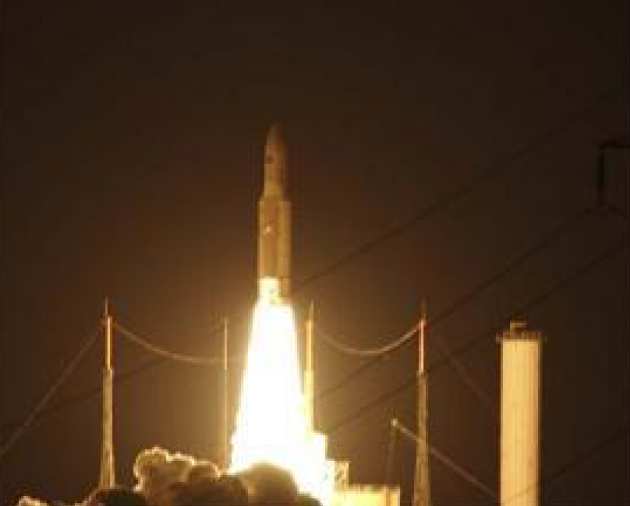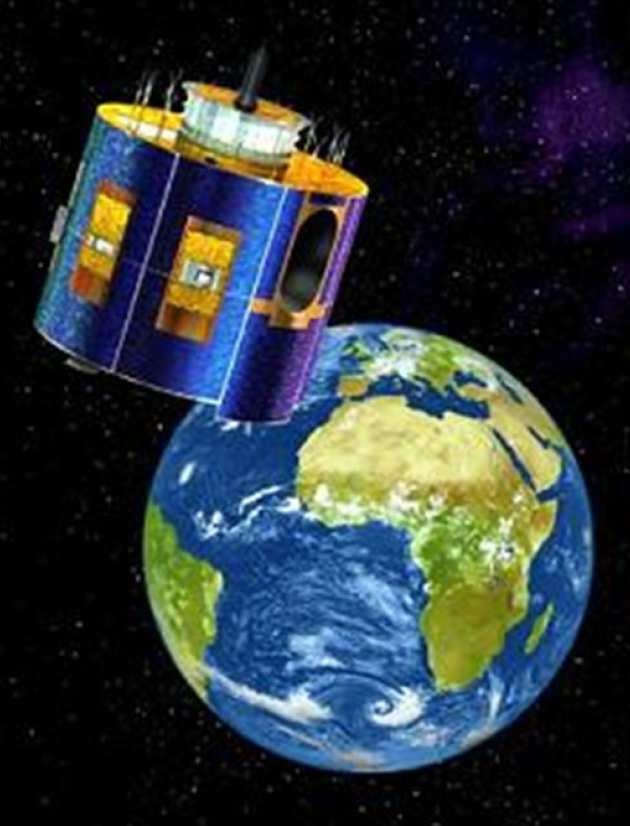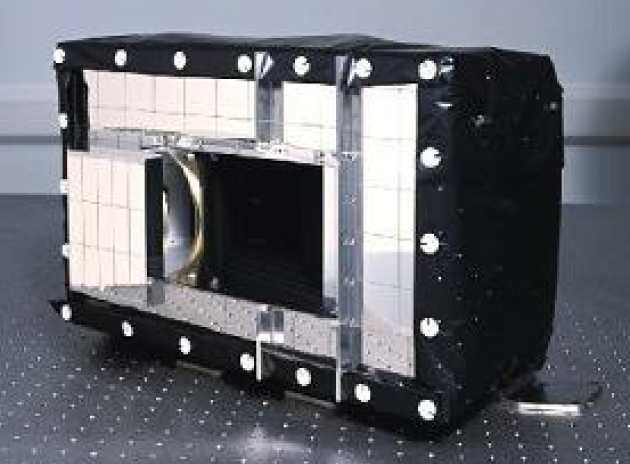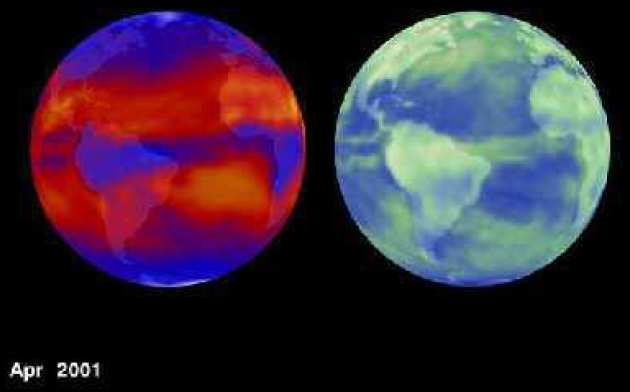GERB Successfully Launched Onboard MSG-1
 After a 24h delay caused by a computer synchronisation problem, Meteosat Second Generation was launched successfully on board an Ariane V rocket (Flight 155), taking off at (approx) 10.45 GMT on the evening of 28 August 2002 on an eastward trajectory from the ESA launch centre in Kourou, French Guiana. Separation of the MSG-1 spacecraft occurred nominally some 36 minutes later. The complete launch sequence was nominal. A scheduled brief check-out of the Geostationary Earth Radiation Budget (GERB) experiment showed all to be OK. The satellite is being raised from the geostationary transfer orbit (GTO) today, to arrive in a circular orbit over 0 deg N, 0 deg W. There will then follow a period of about 2 months during which MSG and its sensors will be switched on and checked out, followed by some months of commissioning, before the whole system goes operational. We will keep posting news items here on the Group News page, and also on the GERB web page. So far, so very good!!.
After a 24h delay caused by a computer synchronisation problem, Meteosat Second Generation was launched successfully on board an Ariane V rocket (Flight 155), taking off at (approx) 10.45 GMT on the evening of 28 August 2002 on an eastward trajectory from the ESA launch centre in Kourou, French Guiana. Separation of the MSG-1 spacecraft occurred nominally some 36 minutes later. The complete launch sequence was nominal. A scheduled brief check-out of the Geostationary Earth Radiation Budget (GERB) experiment showed all to be OK. The satellite is being raised from the geostationary transfer orbit (GTO) today, to arrive in a circular orbit over 0 deg N, 0 deg W. There will then follow a period of about 2 months during which MSG and its sensors will be switched on and checked out, followed by some months of commissioning, before the whole system goes operational. We will keep posting news items here on the Group News page, and also on the GERB web page. So far, so very good!!.
Congratulations go to the whole GERB team, at RAL and in the other centres, and here at IC, where the team under Steve Kellock has done a superb job.
John Harries, GERB Principal Investigator, 29th August 2002
For further information on GERB and MSG-1, read on to the next item on this page which was prepared pre-launch or visit the SPAT group GERB web page.
Launch of MSG-1 Carrying the GERB Instrument
 Climate change is a major scientific problem and potentially an extremely serious threat to global stability. For both these reasons it is vital to understand the processes and mechanisms that control the Earth's climate. To do this we use a combination of simulation of the system using complex computer models, and accurate and long term observations. Ultimately the models must be tested and validated against observations of the real world.
Climate change is a major scientific problem and potentially an extremely serious threat to global stability. For both these reasons it is vital to understand the processes and mechanisms that control the Earth's climate. To do this we use a combination of simulation of the system using complex computer models, and accurate and long term observations. Ultimately the models must be tested and validated against observations of the real world.
Next week, on August 27th, a new European instrument will be launched on board an Ariane V rocket from the European Space Agency centre in Kourou, French Guyana. This new instrument, GERB (the Geostationary Earth Radiation Budget experiment) has been developed by a European consortium led by IC (GERB web page) and RAL (GERB web page) in the UK, and which includes EUMETSAT, ESA, Italy and Belgium. Imperial College (Physics Department, Space and Atmospheric Physics Group) has provided the scientific leadership for this project, and has played a central part in its developments. NERC has provided the research funding for the UK contribution to GERB-1, and for science support for the whole series. Italy and Belgium, as well as the UK, have provided additional national funding. EUMETSAT has funded GERB-2 and GERB-3 through a contract to RAL, IC and others.
GERB is a novel, small instrument flying as a science ‘passenger’ on a new series of operational meteorological geostationary satellites, called Meteosat Second Generation (ESA web page, EUMETSAT web page). MSG is a spinning satellite of 3m diameter. GERB will make the first ever measurements of the Earth’s energy balance from geostationary orbit. High accuracy measurements of the solar radiation absorbed by the Earth, and the infrared energy emitted, will be made each 15 minutes. These new data, together with measurements from existing low Earth orbiting satellites, will be used to test climate theory, and to investigate climatic phenomena such as desertification, dust storms over the Atlantic, rainfall variability, cloud-radiation feedback, food production, surface radiation budget, and many others.
 GERB, pictured on the right, is a small, accurately calibrated radiometer that sits near the edge of MSG (since MSG spins at 100rpm, this produces an acceleration on GERB and all its parts of 18g!). GERB contains a de-spin mirror to remove the effects of this MSG rotation; GERB is about 45x20x15cm3 in size, and weighs about 40kg. The design and development of GERB has been the responsibility of RAL, and I am pleased to acknowledge that they have done an excellent and professional job.
GERB, pictured on the right, is a small, accurately calibrated radiometer that sits near the edge of MSG (since MSG spins at 100rpm, this produces an acceleration on GERB and all its parts of 18g!). GERB contains a de-spin mirror to remove the effects of this MSG rotation; GERB is about 45x20x15cm3 in size, and weighs about 40kg. The design and development of GERB has been the responsibility of RAL, and I am pleased to acknowledge that they have done an excellent and professional job.
SPAT have been responsible for the calibration and characterization of three GERB instruments in the series, -1, -2 and -3, and also for the scientific exploitation of the data from the instrument. In order to achieve the former we have a team of scientists working in the SPAT Earth Observation Characterisation Facility on level 2 of Blackett building, under the leadership of Steve Kellock. To accomplish the latter, John Harries leads the GERB International Science Team, which has members from Spain, Italy, Belgium, Germany, the US and from several institutions in the UK, including IC. Once in flight, GERB will be operated from IC and the data processing will be carried out at RAL.
MSG has been developed by EUMETSAT and ESA, with support from European member states. MSG will carry a high resolution, multi-channel imager called SEVIRI as its prime payload, to be used directly in weather forecasting. SEVIRI data will be used intimately in the GERB data processing.
 Should we believe "climate change"? In my view, the answer is "Yes": there are detectable and significant changes occurring in a number of measurable parameters, including surface temperature (see figure, right: Observed and modelled trends in global surface temperature, 1850- 2000) that we must understand.
Should we believe "climate change"? In my view, the answer is "Yes": there are detectable and significant changes occurring in a number of measurable parameters, including surface temperature (see figure, right: Observed and modelled trends in global surface temperature, 1850- 2000) that we must understand.
BUT, should we believe that we understand "climate change" well enough to predict our future? In my view, a definite NO! Feedback processes, especially clouds, water vapour, oceans, are very poorly understood, and cause large uncertainties (see the figure, below right). Much more research is needed to understand how the feedback processes in the complex non-linear system called climate actually do determine climate and its variability.
So, more accurate, better sampled, better inter-calibrated observations are needed, and MSG/SEVIRI/GERB is a world-leading European initiative to achieve just that.
 Many people in SPAT, as well as outside IC, have contributed to the development, testing and scientific understand ing of the GERB instruments, and to name them all is difficult if we are to avoid leaving someone out. Suffice it to say that the whole GERB team here at Imperial College has done a superb job, in hardware, software and scientific roles, on what would be regarded as a miniscule budget in the outside world. These efforts have been made with enthusiasm, intelligence and determination, and it has been a great pleasure for me to be part of this effort. We thank NERC and EUMETSAT for supporting our team.
Many people in SPAT, as well as outside IC, have contributed to the development, testing and scientific understand ing of the GERB instruments, and to name them all is difficult if we are to avoid leaving someone out. Suffice it to say that the whole GERB team here at Imperial College has done a superb job, in hardware, software and scientific roles, on what would be regarded as a miniscule budget in the outside world. These efforts have been made with enthusiasm, intelligence and determination, and it has been a great pleasure for me to be part of this effort. We thank NERC and EUMETSAT for supporting our team.
IMAGE LEFT: Infrared emission (left) and solar reflection, largely modulated by clouds.
If ESA can do their stuff next Tuesday, and if our little beauty can cope with that 18g, we look forward to the next phase of this project, which will be processing and analysing the data that we receive through the dedicated network which includes ESOC, RAL and the Royal Meteorological Institute in Brussels.
Yikes!
John Harries 20th August 2002
The latest news leading up to the MSG launch can be found on the following web sites: